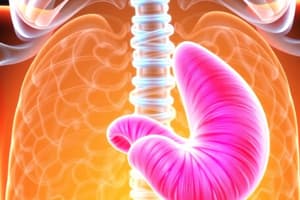Podcast
Questions and Answers
List 4 signs/symptoms of dysphagia.
List 4 signs/symptoms of dysphagia.
Inability to recognize food, difficulty placing food in mouth, inability to control food and or saliva, coughing before, during, and/or after a meal, reoccuring pnemonia (PNA), weight loss, wet/gurgly vocal quality
Please identify 4 professionals who are most often a part of a multidisciplinary treatment approach to dysphagia.
Please identify 4 professionals who are most often a part of a multidisciplinary treatment approach to dysphagia.
OT, dietitian, nurses, doctors (neurologists, ENTs, GI, etc)
During this phase, rotary and lateral tongue movements control placement of the bolus on the teeth and within the oral cavity
During this phase, rotary and lateral tongue movements control placement of the bolus on the teeth and within the oral cavity
- Oral (correct)
- Pharyngeal
- Esophageal
- None of the above
This is the longest stage and lasts about 8-20 seconds.
This is the longest stage and lasts about 8-20 seconds.
During this phase, the tongue drops down and pulls posteriorly.
During this phase, the tongue drops down and pulls posteriorly.
During this phase, the larynx moves up and forward as a unit
During this phase, the larynx moves up and forward as a unit
This cranial nerve supplies motor function the muscles of the tongue. Also the only cranial nerve that provides muscle function.
This cranial nerve supplies motor function the muscles of the tongue. Also the only cranial nerve that provides muscle function.
This cranial nerve carries signals from the taste buds of the anterior ⅔ of the tongue.
This cranial nerve carries signals from the taste buds of the anterior ⅔ of the tongue.
This nerve provides sensation to the posterior ⅓ of the tongue; motor supply to the stylopharyngeus muscle (elevates the pharynx during swallowing)
This nerve provides sensation to the posterior ⅓ of the tongue; motor supply to the stylopharyngeus muscle (elevates the pharynx during swallowing)
Vallecular residue, as seen via MBS or FEES, may point to weakness of:
Vallecular residue, as seen via MBS or FEES, may point to weakness of:
Bony outgrowths of the cervical vertebrae that can impinge on hyolaryngeal excursion, epiglottic deflection or UES opening are called:
Bony outgrowths of the cervical vertebrae that can impinge on hyolaryngeal excursion, epiglottic deflection or UES opening are called:
Aspiration pneumonia most often occurs in which lobe?
Aspiration pneumonia most often occurs in which lobe?
FEES does not require travel and can be performed at bedside
FEES does not require travel and can be performed at bedside
MBS can be done bedside
MBS can be done bedside
FEES is more expensive than MBS
FEES is more expensive than MBS
Both MBS and FEES are free from radiation exposure
Both MBS and FEES are free from radiation exposure
All phases of swallowing can be seen with MBS.
All phases of swallowing can be seen with MBS.
The oral phase and aspiration are easily viewed with FEES
The oral phase and aspiration are easily viewed with FEES
What are 4 possible pulmonary complication association with aspiration PNA?
What are 4 possible pulmonary complication association with aspiration PNA?
Decreased epiglottic closure or inversion and decreased laryngeal closure can result in penetration and/or aspiration ______ the swallow.
Decreased epiglottic closure or inversion and decreased laryngeal closure can result in penetration and/or aspiration ______ the swallow.
What region of the brain controls the reflexive swallow?
What region of the brain controls the reflexive swallow?
This muscle prevents the bolus from leaking out of the mouth during the oral phase
This muscle prevents the bolus from leaking out of the mouth during the oral phase
This muscles depresses and retracts the tongue; makes the dorsum more convex
This muscles depresses and retracts the tongue; makes the dorsum more convex
Located in the posterior oral cavity, this area is the most stimulable area to trigger a swallow
Located in the posterior oral cavity, this area is the most stimulable area to trigger a swallow
Large u-shaped bone; attachment for extrinsic laryngeal muscles.
Large u-shaped bone; attachment for extrinsic laryngeal muscles.
This muscles raises the floor of the mouth and aids in pulling the hyoid forward.
This muscles raises the floor of the mouth and aids in pulling the hyoid forward.
This U-Shaped bone is positioned horizontally in the neck at the level of C3
This U-Shaped bone is positioned horizontally in the neck at the level of C3
The _____ is considered the "swallowing center" of the brain.
The _____ is considered the "swallowing center" of the brain.
According to ASHA, pharyngeal dysphagia can be diagnosed with a clinical swallowing evaluation (CSE).
According to ASHA, pharyngeal dysphagia can be diagnosed with a clinical swallowing evaluation (CSE).
The presence of a strong productive cough is a positive prognostic factor for patients with dysphagia.
The presence of a strong productive cough is a positive prognostic factor for patients with dysphagia.
The effortful swallow is designed to help what kinds of problems?
The effortful swallow is designed to help what kinds of problems?
This feeding tube involves creating a stoma in which the feedings delivered directly to the stomach.
This feeding tube involves creating a stoma in which the feedings delivered directly to the stomach.
This is a method of getting nutrition into your body through your veins
This is a method of getting nutrition into your body through your veins
Tube inserted through one are and into the stomach
Tube inserted through one are and into the stomach
This tube is inserted into the oral cavity and leads down into the stomach
This tube is inserted into the oral cavity and leads down into the stomach
Flashcards are hidden until you start studying



